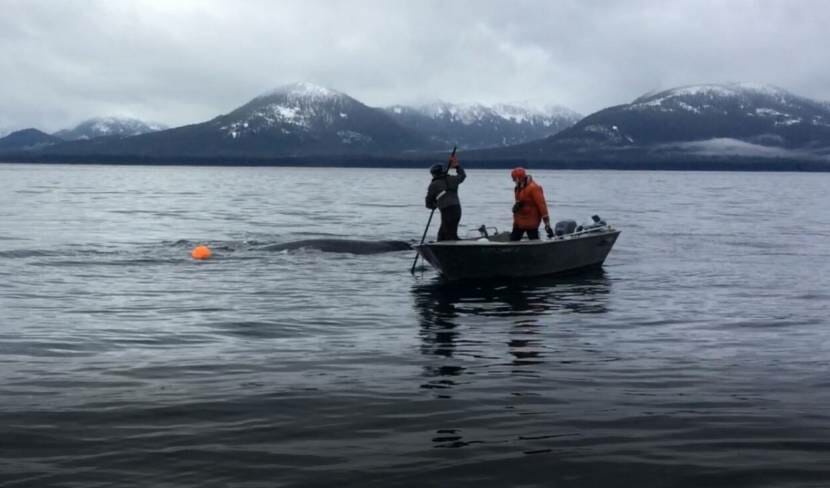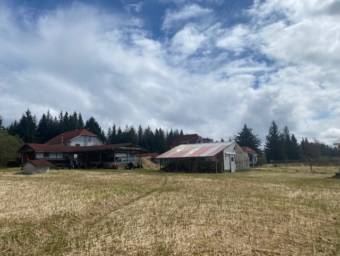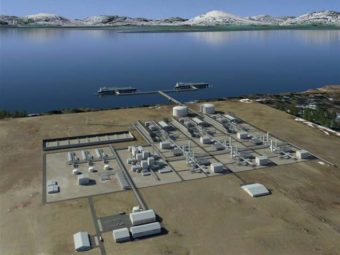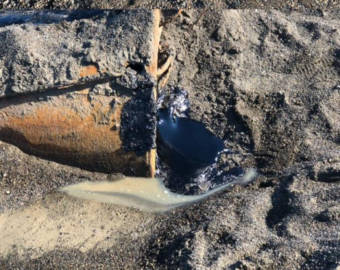
It was the middle of the night on the day before Thanksgiving when a gut-wrenching sound awoke residents in the Chichagof Island town of Tenakee Springs.
“It was a pretty sad and mournful and awful sound,” resident Wendy Stern said.
Resident Steve Lewis described it as a plaintive cry for help.
“It was just this sort of whistling and groaning,” Lewis said.
Neither of them actually heard the noises until later in the day when the sound carried closer to their homes. But they were among the first to respond to its source — a 40-foot humpback whale caught in tanner crab pot gear that, resident Gordon Chew said, came from Kodiak around 630 miles away.
“People were very shaken up after losing a lot of sleep and listening to a bellowing humpback whale all night,” Chew said. He awoke to calls from those distressed residents.
Large whale entanglements are fairly rare in Alaska. Only around 10 are spotted each year, and most whales shed the marine debris or fishing gear on their own. But once or twice a year, human intervention is required to save a whale’s life.
As Chew, Lewis and Stern would soon learn, this was one of those times. All three are part of a network of volunteers trained by NOAA to respond to whale entanglements.
As soon as they got the go-ahead from the National Oceanic and Atmospheric Administration, Chew and Lewis headed out in a skiff to collect footage while Stern followed in a support boat. An orange buoy marked the spot where the animal was now frozen in place. Slowly, Chew lowered a waterproof video camera on a long pole into the water.
“It had an anchor on the tail, lines going forward, a buoy in its mouth, another buoy at its tail. And it really could barely move,” Stern said. “It was awful to see an animal all bound up like that.”
“We could hear it breathing and it was labored, the way it was pinched and folded in half,” Chew said.
Then, they relayed the photos and footage to people like large whale entanglement specialist Sadie Wright at NOAA.
“It was amazing that people were willing to give up their holiday preparations in order to get this animal free,” Wright said. “We were able to work with those folks in Tenakee to evaluate the photos and the video, come up with a safe and deliberate plan to do these disentanglement tactics from a distance to keep people safe,” Wright said.
That’s because disentangling a whale is dangerous. Both Chew and Lewis have had extensive training, have access to specialized tools and assisted with multiple entanglements over the years. And they consulted with NOAA every step of the way.
Chew said even some of the most experienced responders have been killed.
“You know a 40-ton animal can do an awful lot of damage. A pectoral fin can weigh 900 pounds, just the fin off the side of the animal. So I mean if it comes down on you or your boat, it would be very very bad,” Chew said.
By the time they were ready to try to cut the whale free, it was Thanksgiving morning. Two more boats joined them. A long, careful dance began. What Stern described as an agonizingly slow process.
“Everyone thinks of maybe some kind of YouTube video where you go out and there’s these heroes and maybe they’re in wet suits and they go down and they cut off the gear and the whale jumps in the air and there’s a rainbow,” Stern said. “It’s just not that way.”
First, they cut the whale free from the heavy crab pot weighing it down. Then, they followed the whale as it began to swim, hoping it would shed the remaining gear. Chew made several unsuccessful attempts to cut it away.
“I wish I could’ve done more. And I just tried and tried and tried,” he said. “And it was one of the most challenging things I’ve ever done, and I just stayed focused on trying to be successful.”
Finally, as the daylight waned and the whale approached the rougher waters of Chatham Strait, they cut a buoy off the base of its tail. It took a dive and disappeared, just in time for Thanksgiving dinner.
“Helping a big animal like that is a wonderful way to spend Thanksgiving,” Lewis said. “We were really happy to be able to spend our day doing something really good for the world or at least for that whale.”
But like most real-life stories, this one doesn’t have a definitive happy ending. The whale was still trailing some lines and had a buoy stuck in its mouth. NOAA experts said it’s highly likely that the powerful animal will shake the remaining gear. But unless someone spots the 16-year-old humpback again, who’s since been photo-identified as a known Southeast Alaska whale, they won’t know for sure.
“It would be nice to know the end of the story. It’s part of the part for me that’s kind of hard,” Stern said. “I wish I knew what ultimately happens to this whale.”
But maybe, just maybe, one of Tenakee’s many whale-loving mariners will deliver that happy ending soon.



